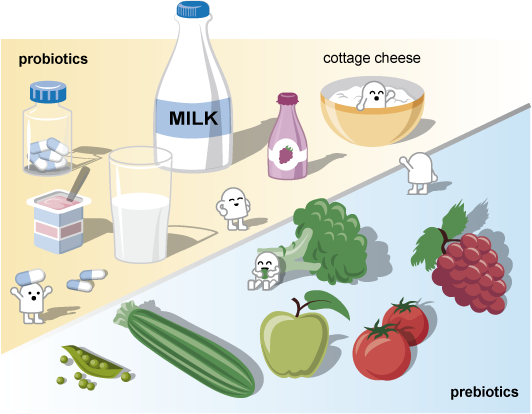5.1 Prebiotics and probiotics
One way in which the health of the gut microbiome can be improved is through the use of prebiotics and probiotics. Although these have similar names, they contain quite different substances designed to improve the health of the gut microbiome.
Prebiotics act as a food source for the beneficial bacteria in the gut microbiome and help those bacteria to thrive in order to improve the balance of bacteria within the microbiome. Prebiotics are typically substances that cannot be broken down by human enzymes, that can withstand the acidic environment of the stomach, and which are not absorbed in the upper GI tract.
-
Question 25
Why might a prebiotic need these characteristics?
-
A substance that is broken down in the acidic environment of the stomach, by human enzymes, or be absorbed in the upper GI tract, might not reach or be available to the majority of the gut microbiome, located in the large intestine.
Prebiotics are typically complex carbohydrates, and can be found naturally in high quantities in lots of different food sources, but especially:
- legumes, beans, and peas
- oats
- bananas
- berries
- Jerusalem artichokes (not the same as regular artichokes)
- asparagus
- dandelion greens
- garlic
- leeks
- onions.
In contrast, probiotics are a collection of live, beneficial microorganisms, often bacteria or yeasts, that are ingested with the aim of colonising the gut to improve the quality and diversity of the gut microbiota. Probiotic bacteria are found in fermented foods, such as live yoghurt, kimchi, sauerkraut, and pickled vegetables, but there are many other commercial mixtures and dietary supplements available too, such as probiotic yoghurt drinks and kefir.

Pharmaceutical-grade probiotics, which contain very high amounts of microorganisms, have been shown to have some benefit in clinical trials (NHS, 2022). The high number of microorganisms in pharmaceutical-grade probiotics is thought to result in some of the bacteria being able to survive the highly acidic stomach and beyond. The benefits of commercially-bought probiotic supplements are still controversial, as they contain low concentrations of the microorganisms, the majority of which will most likely be destroyed by the highly acidic environment of the stomach. However, there is still some anecdotal evidence (i.e. not scientific, based on personal accounts) that these may provide some benefit in specific intestinal disorders. To date, there has been no scientific evidence to indicate that there is any benefit to healthy individuals taking probiotics (Jabr, 2017).
You are going to finish off this OpenLearn course by learning about a slightly less palatable way to improve the health of the gut microbiome – faecal transplant!
